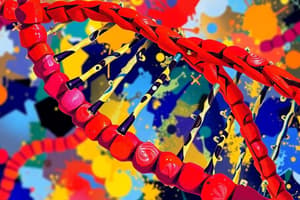Podcast
Questions and Answers
What is the shape of a DNA molecule called?
What is the shape of a DNA molecule called?
Double helix
Which of your body's cells contain DNA?
Which of your body's cells contain DNA?
All body cells
What can be determined about DNA from its name?
What can be determined about DNA from its name?
It is a nucleic acid
What can DNA best be compared to in a building?
What can DNA best be compared to in a building?
Which of the following is the correct name of DNA?
Which of the following is the correct name of DNA?
Which organelle contains DNA?
Which organelle contains DNA?
What is the process by which RNA is made from DNA?
What is the process by which RNA is made from DNA?
What are the rungs of the DNA ladder made of?
What are the rungs of the DNA ladder made of?
Which of the following nitrogen bases are not found in DNA?
Which of the following nitrogen bases are not found in DNA?
What is the sugar in DNA called?
What is the sugar in DNA called?
Which of the following nitrogen bases are not found in DNA?
Which of the following nitrogen bases are not found in DNA?
What is a gene?
What is a gene?
What is a sugar in DNA called?
What is a sugar in DNA called?
What takes the genetic code of DNA to the cytoplasm?
What takes the genetic code of DNA to the cytoplasm?
What is the process by which DNA makes a copy of itself called?
What is the process by which DNA makes a copy of itself called?
How many amino acids do three nucleotides code for?
How many amino acids do three nucleotides code for?
How does DNA differ from RNA?
How does DNA differ from RNA?
According to the base pairing rules, how do nitrogen bases pair together?
According to the base pairing rules, how do nitrogen bases pair together?
What does a nucleotide consist of?
What does a nucleotide consist of?
What is the DNA molecule held together by?
What is the DNA molecule held together by?
If the sequence of a DNA strand is AAGCCA, what are the bases on its complementary strand?
If the sequence of a DNA strand is AAGCCA, what are the bases on its complementary strand?
Which scientists were first in discovering the structure of DNA?
Which scientists were first in discovering the structure of DNA?
What role did Rosalind Franklin play in the discovery of the structure of DNA?
What role did Rosalind Franklin play in the discovery of the structure of DNA?
What are damages or changes to a DNA sequence called?
What are damages or changes to a DNA sequence called?
What are the building blocks of DNA?
What are the building blocks of DNA?
Which trait is determined completely by your DNA?
Which trait is determined completely by your DNA?
Flashcards are hidden until you start studying
Study Notes
DNA Structure and Function
- DNA is shaped like a double helix, resembling twisted ladder rungs.
- All body cells contain DNA, making it universal within the human body.
- DNA, or deoxyribonucleic acid, functions as a nucleic acid crucial for genetic information storage.
DNA Composition
- The blueprint analogy highlights DNA's role in directing biological functions.
- DNA comprises nitrogen bases (adenine, thymine, cytosine, and guanine) forming the rungs of the ladder.
- The sugar in DNA is glucose, essential for its structural integrity.
- Each nucleotide consists of a nitrogen base, a sugar, and a phosphate group.
- DNA is held together by covalent bonds, providing stability to its structure.
Gene Characteristics
- A gene is defined as a segment of DNA responsible for coding proteins, influencing traits like hair color.
- Three nucleotides code for one amino acid, serving as the basic coding unit for proteins.
Differences between DNA and RNA
- DNA differs from RNA primarily due to the type of sugar it contains (deoxyribose vs. ribose).
- Uracil is a nitrogen base found in RNA but is absent in DNA, which contains thymine instead.
Genetic Processes
- The process of DNA replication involves making a copy of the DNA molecule, ensuring genetic continuity.
- RNA synthesis from DNA occurs through a process known as transcription, resulting in mRNA (messenger RNA), which transports genetic information to the cytoplasm.
Base Pairing Rules
- According to base pairing rules, adenine pairs with thymine, and cytosine pairs with guanine in DNA sequences.
- Given a specific DNA sequence (AAGCCA), its complementary strand will have the bases ACCGAA.
Discoveries in DNA Research
- James Watson and Francis Crick are credited with the discovery of DNA's structure, expanding the understanding of genetics.
- Rosalind Franklin significantly contributed by capturing the first photographs of DNA, aiding in the structural analysis.
Mutations and Impacts
- Changes or damages to a DNA sequence are termed mutations, which can affect gene function and ultimately influence traits.
Studying That Suits You
Use AI to generate personalized quizzes and flashcards to suit your learning preferences.



